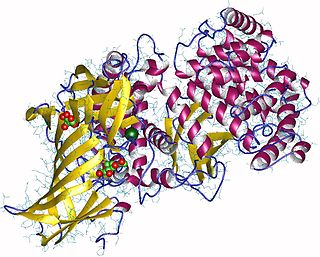Related Research Articles

Membrane alanyl aminopeptidase also known as alanyl aminopeptidase (AAP) or aminopeptidase N (AP-N) is an enzyme that in humans is encoded by the ANPEP gene.
An exopeptidase is any peptidase that catalyzes the cleavage of the terminal peptide bond; the process releases a single amino acid, dipeptide or a tripeptide from the peptide chain. Depending on whether the amino acid is released from the amino or the carboxy terminal, an exopeptidase is further classified as an aminopeptidase or a carboxypeptidase, respectively. Thus, an aminopeptidase, an enzyme in the brush border of the small intestine, will cleave a single amino acid from the amino terminal, whereas carboxypeptidase, which is a digestive enzyme present in pancreatic juice, will cleave a single amino acid from the carboxylic end of the peptide.

Aminopeptidases are enzymes that catalyze the cleavage of amino acids from the amino terminus (N-terminus) of proteins or peptides (exopeptidases). They are widely distributed throughout the animal and plant kingdoms and are found in many subcellular organelles, in cytosol, and as membrane components. Aminopeptidases are used in essential cellular functions. Many, but not all, of these peptidases are zinc metalloenzymes.
Procollagen peptidase is an endopeptidase involved in the processing of collagen. The proteases removes the terminal peptides of the procollagen. Deficiency of these enzymes leads to dermatosparaxis or Ehlers–Danlos syndrome.
Glutamyl aminopeptidase (EC 3.4.11.7, aminopeptidase A, aspartate aminopeptidase, angiotensinase A, glutamyl peptidase, Ca2+-activated glutamate aminopeptidase, membrane aminopeptidase II, antigen BP-1/6C3 of mouse B lymphocytes, L-aspartate aminopeptidase, angiotensinase A2) is an enzyme encoded by the ENPEP gene. Glutamyl aminopeptidase has also recently been designated CD249 (cluster of differentiation 249).

Leucyl aminopeptidases are enzymes that preferentially catalyze the hydrolysis of leucine residues at the N-terminus of peptides and proteins. Other N-terminal residues can also be cleaved, however. LAPs have been found across superkingdoms. Identified LAPs include human LAP, bovine lens LAP, porcine LAP, Escherichia coli LAP, and the solanaceous-specific acidic LAP (LAP-A) in tomato.

N-Formylmethionyl-leucyl-phenylalanine is an N-formylated tripeptide and sometimes simply referred to as chemotactic peptide is a potent polymorphonuclear leukocyte (PMN) chemotactic factor and is also a macrophage activator.

Methionine aminopeptidase 2 is an enzyme that in humans is encoded by the METAP2 gene.

Dipeptidyl-peptidase 3 is an enzyme that in humans is encoded by the DPP3 gene.

Dipeptidyl peptidase I is an enzyme. This enzyme catalyses the following chemical reaction

Ubenimex (INN), also known more commonly as bestatin, is a competitive, reversible protease inhibitor. It is an inhibitor of arginyl aminopeptidase (aminopeptidase B), leukotriene A4 hydrolase (a zinc metalloprotease that displays both epoxide hydrolase and aminopeptidase activities), alanyl aminopeptidase (aminopeptidase M/N), leucyl/cystinyl aminopeptidase (oxytocinase/vasopressinase), and membrane dipeptidase (leukotriene D4 hydrolase). It is being studied for use in the treatment of acute myelocytic leukemia and lymphedema. It is derived from Streptomyces olivoreticuli. Ubenimex has been found to inhibit the enzymatic degradation of oxytocin, vasopressin, enkephalins, and various other peptides and compounds.
Dipeptidyl-peptidase III is an enzyme. This enzyme catalyses the following chemical reaction
Tripeptide aminopeptidase is an enzyme. This enzyme catalyses the following chemical reaction:
Prolyl aminopeptidase is an enzyme. This enzyme catalyses the following chemical reaction

Aminopeptidase Y is an enzyme. This enzyme catalyses the following chemical reaction
Methionyl aminopeptidase is an enzyme. This enzyme catalyses the following chemical reaction
Dipeptidyl-peptidase II is an enzyme. This enzyme catalyses the following chemical reaction:
Acylaminoacyl-peptidase is an enzyme. This enzyme catalyses the following chemical reaction
Pyroglutamyl-peptidase I (EC 3.4.19.3, also known as Pyrrolidonyl peptidase, is an enzyme found in bacteria, plants and animals.
Pyroglutamyl-peptidase II is an enzyme. This enzyme catalyses the following chemical reaction
References
- ↑ Suda H, Yamamoto K, Aoyagi T, Umezawa H (November 1980). "Purification and properties of N-formylmethionine aminopeptidase from rat liver". Biochimica et Biophysica Acta (BBA) - Enzymology. 616 (1): 60–7. doi:10.1016/0005-2744(80)90263-6. PMID 7437450.